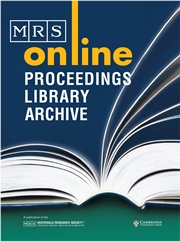Article contents
Recent Progress On The Modeling Of Laser Surface Cleaning
Published online by Cambridge University Press: 10 February 2011
Abstract
Laser cleaning has emerged to effectively remove contaminants from solid surfaces. In this paper, recent progress on laser cleaning has been studied. First, a cleaning model is established for removal of particles from substrate surfaces. The model not only explains the influence of fluence on cleaning efficiency, but also predicts the cleaning thresholds. Following that, the optical resonance and near field effect are discussed for transparent particles with a size of α ∼ λ (radiation wavelength) which strongly influences the intensity distribution in the contacted area (substrate surface). The characterization of ejected particles during laser cleaning is finally investigated. It is found that the particle distribution curves closely fit to Gaussian curve.
- Type
- Research Article
- Information
- Copyright
- Copyright © Materials Research Society 2000
References
- 1
- Cited by


